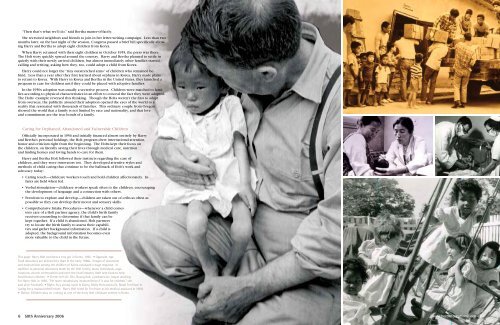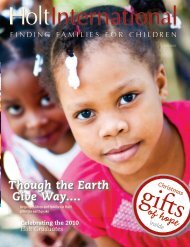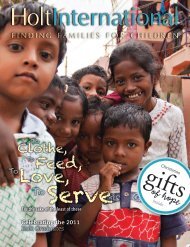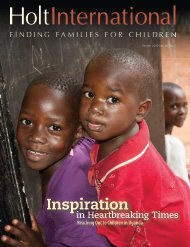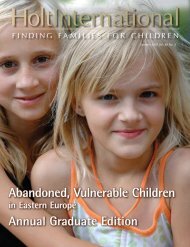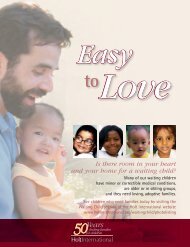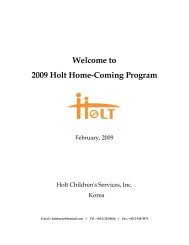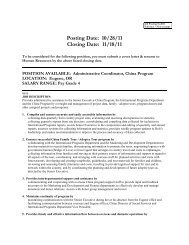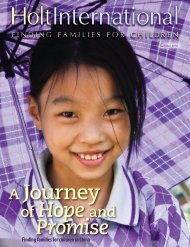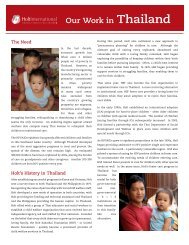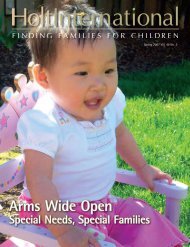My Name is Life - Holt International
My Name is Life - Holt International
My Name is Life - Holt International
You also want an ePaper? Increase the reach of your titles
YUMPU automatically turns print PDFs into web optimized ePapers that Google loves.
“Then that’s what we’ll do,” said Bertha matter-of-factly.<br />
She recruited neighbors and friends to join in her letter-writing campaign. Less than two<br />
months later, on the last night of the session, Congress passed a brief bill specifically allowing<br />
Harry and Bertha to adopt eight children from Korea.<br />
When Harry returned with their eight children in October 1955, the press was there.<br />
The <strong>Holt</strong> story quickly spread around the country. Harry and Bertha planned to settle in<br />
quietly with their newly arrived children, but almost immediately other families started<br />
calling and writing, asking how they, too, could adopt a child from Korea.<br />
Harry could not forget the “tiny outstretched arms” of children who remained behind.<br />
Less than a year after they first learned about orphans in Korea, Harry made plans<br />
to return to Korea. With Harry in Korea and Bertha in the United States, they launched a<br />
program to care for children until they could be placed with adoptive families.<br />
In the 1950s adoption was usually a secretive process. Children were matched to families<br />
according to physical character<strong>is</strong>tics in an effort to conceal the fact they were adopted.<br />
The <strong>Holt</strong>s’ example reversed th<strong>is</strong> thinking. Though the <strong>Holt</strong>s weren’t the first to adopt<br />
from overseas, the publicity around their adoption opened the eyes of the world to a<br />
reality that resonated with thousands of families. Th<strong>is</strong> ordinary couple from Oregon<br />
showed the world that a family <strong>is</strong> not limited by race and nationality, and that love<br />
and commitment are the true bonds of a family.<br />
Caring for Orphaned, Abandoned and Vulnerable Children<br />
Officially incorporated in 1956 and initially financed almost entirely by Harry<br />
and Bertha’s personal holdings, the <strong>Holt</strong> program drew international attention,<br />
honor and critic<strong>is</strong>m right from the beginning. The <strong>Holt</strong>s kept their focus on<br />
the children, on literally saving their lives through medical care, nutrition<br />
and finding homes and loving hands to care for them.<br />
Harry and Bertha <strong>Holt</strong> followed their instincts regarding the care of<br />
children, and they were innovators too. They developed attentive styles and<br />
methods of child caring that continue to be the hallmark of <strong>Holt</strong>’s work and<br />
advocacy today:<br />
• Caring touch—childcare workers touch and hold children affectionately. Infants<br />
are held when fed.<br />
• Verbal stimulation—childcare workers speak often to the children, encouraging<br />
the development of language and a connection with others.<br />
• Freedom to explore and develop—children are taken out of cribs as often as<br />
possible so they can develop their motor and sensory skills.<br />
• Comprehensive Intake Procedures—whenever a child comes<br />
into care of a <strong>Holt</strong> partner agency, the child’s birth family<br />
receives counseling to determine if that family can be<br />
kept together. If a child <strong>is</strong> abandoned, <strong>Holt</strong> partners<br />
try to locate the birth family to assess their capabilities<br />
and gather background information. If a child <strong>is</strong><br />
adopted, the background information becomes even<br />
more valuable to the child in the future.<br />
Th<strong>is</strong> page: Harry <strong>Holt</strong> comforts a tiny girl in Korea, 1955. • Opposite, top:<br />
Food donations are delivered to Ilsan in the early 1960s. Images of starvation<br />
and malnutrition among the children of Korea catalyzed a huge response. In<br />
addition to personal donations made by the <strong>Holt</strong> family, many individuals, organizations,<br />
church communities and even the food industry itself sent food to help<br />
feed Korean children. • Center left: Dr. Cho, Byung Kuk, a pediatrician, began working<br />
for Harry <strong>Holt</strong> in 1959. “He never minded any inconvenience if it was for children,” she<br />
said after h<strong>is</strong> death. • Right: As a young nurse in Korea, Molly <strong>Holt</strong> ass<strong>is</strong>ts Dr. Ralph Ten Have in<br />
caring for a malnour<strong>is</strong>hed infant. Harry <strong>Holt</strong> hired Dr. Ten Have as h<strong>is</strong> medical ass<strong>is</strong>tant in 1958.<br />
• Below: Children play on a swing at one of the early <strong>Holt</strong> childcare centers in Korea.<br />
6 50th Anniversary 2006<br />
www.holtinternational.org 7


